Over the past few weeks, I’ve been looking at research on how we manage our yards and how those decisions impact the ecosystems around us. Certainly when we mow or fertilize or add ornamental species to our lawns we are altering the space, but there are other ways that we interact with our yards and the species (plant, animal, fungi, you name it) that live there. So what can we do to make our yards healthy, productive areas for wildlife and enjoyable recreational spaces for us? And can we help advance the science of lawn management?
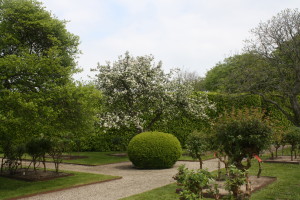
Whether your yard is tiny or a large estate, there are many things you can do to make it more hospitable to wildlife while still enjoying the space yourself.
 As it turns out, there are lots of resources for information and many, many ways we can make small changes to how we care for the spaces around our homes. One of the suggestions from a study in New Jersey (Mitteager et al. 2006) when approaching our yards is to think about the yard image we want to see when we look outside rather than specific plants we want to use- that way we have more opportunities to incorporate native plant species while still getting the yard-feel we want.
As it turns out, there are lots of resources for information and many, many ways we can make small changes to how we care for the spaces around our homes. One of the suggestions from a study in New Jersey (Mitteager et al. 2006) when approaching our yards is to think about the yard image we want to see when we look outside rather than specific plants we want to use- that way we have more opportunities to incorporate native plant species while still getting the yard-feel we want.
A great place to look for information and even training in yard care is your local county agricultural extension or the agricultural schools at state colleges and universities. Many of these entities are doing lawn care research and have programs to assist you in better understanding your specific lawn conditions and your options for lawn care. A number of state and non-profit organizations have programs tailored to homeowners in local climates, but they also provide some general guidelines applicable to yards in a wide variety of places. Some informative examples include:
• The Lady Bird Johnson Wildflower Center sells a native turf mix for yards in Texas, as well as providing information on landscaping with native plants
• West Virginia has a Wild Yards Program, there are guidelines for Florida-Friendly Landscaping and UFL has a Living Green website, the University of Minnesota provides best practices for supporting insect pollinators, Maine has a Yardscaping program, and OSU’s guidance for butterfly gardens includes exotics to avoid
Working across a larger area,
• The Audubon Society has suggestions for hummingbird-friendly yards
• The EPA has a Greenscapes website with information on water conservation, landscaping, wildlife, and other yard care issues
And for those of you looking to really get into the nuts and bolts of your yards and then collect data for scientists
• Carol West (2013) provides instructions on how she did a lawn species inventory to better understand the diversity of her yard
• The Cornell Lab (the same group that runs the eBird site which lets you contribute bird sightings to help researchers track population and species changes) has a YardMap program where they ask you to map your yard- they want to know about plants, animals, etc. and they provide guides on making changes to how you manage the space. They also highlight amazing yards across the country. This program sounds fantastic and it makes me long for a yard of my own again!
There are many opportunities for us to create inviting, ecologically-minded yards that are fun for us and provide important ecosystem services for the environments around us. I’m pretty sure I’ve only scratched the surface of this and our options can take us in many different directions, but it seems that a few larger themes are relevant here: think about how often we mow our lawns and consider reducing the frequency and raising the height of the blades; think about how often we fertilize, water, and use pesticides and try to make these more efficient; and look for ways to incorporate general floral diversity, and specifically native plants, in our yards. Starting from there, we’ve got many options for making our yards greater forces for good.
Cited works:
Mitteager, WA, Burke, A and KF Nordstrom. 2006. Restoring natural landscapes on private shorefront properties in New Jersey, USA. Journal of Coastal Research SE 39: 890-897.
West, C. 2013. What’s in your lawn? Wellington Botanical Society Bulletin 53: 2-7.
Some of the more recent research into lawn science has focused on the people-yard relationship and how different management practices influence the lawns we see. Starting with the first of those, why do we put so much effort into lawns? Some researchers have suggested that our yards are a statement about how we want to be seen by others since front yards often get more attention than back yards (Daniels & Kirkpatrick 2006)- we’re judged by what can be seen from the road. The role of yards as status symbols was reflected by Larson et al. (2010) who found that, in an arid environment, more-affluent neighborhoods featured yards which combined desert landscaping with lush irrigated ‘oases’ of vegetation; the first type of yard is more reflective of the native environment, while the second is a traditional element of home ownership- combining the two is a statement about owner resources. Here in the US, having a green lawn with oak or elm or other shade trees is often linked to achievement of ‘the American Dream’ (Bormann et al. 2001). Lawns provide space for recreation and social interaction, and for some people they offer a connection to ‘nature’. This last quality is interesting because it leads to some behaviors which might seem counterintuitive. In Larson et al.’s (2010) study, participants who voiced ‘pro-environment’ views (meaning having concern for habitat loss, pollution, etc.) were more likely to have grass lawns despite living in an arid environment where grass lawns require more irrigation; these same grass lawns also received more fertilizer input than yards with native flora. For these landowners, ‘nature’ meant a green space, even in the desert.
What are the effects of our management choices? As I mentioned in my last post, mowing has the biggest impact on the ecosystem of our lawns. One thing that I noticed in reading these studies was that “mowing often” seems to be loosely defined- a study in Paris (Bertoncini et al. 2012) said that mowing was ‘highly frequent’ at 18-24 times a year which would translate into mowing 3-4 times per month for 6 months, while Thompson et a. (2004) included lawns mown every few days. In contrast, Pal et al. (2013) considered ‘regular mowing’ to be 1-2 times per month. What if your main concern is a lush, green lawn? Alumai et al. (2009) compared 4 types of lawn management: care from a commercial company, landowners using consumer lawn care products according to product recommendations, integrated pest management (which means that pesticides are not applied regularly, but when pest populations reach a certain level), and organic lawn care. Over three years of monitoring, lawns maintained by the commercial company had the lowest weed cover, lowest number of white grub pests, and highest lawn quality, but were also the most expensive to maintain. In contrast, the lawns which were managed following instructions from consumer lawn care products, while least expensive to maintain, had the highest levels of weed cover and lowest lawn quality. Alumai et al. (2009) suggested that the integrated pest management and organic options offered slightly lowered lawn quality, but were more economical than using a commercial company; in addition, the integrated pest management strategy had lower chemical inputs than the lawns managed by the commercial company and the organic lawns received inputs from corn gluten meal, boron, and feather-bone-soybean fertilizer instead of synthetic products.
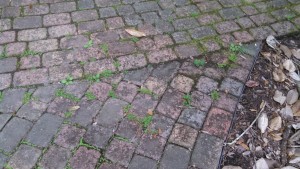
I counted at least 7 plant species in this section of brick pathway on campus
In case you are wondering how more-traditional yard care systems compare with our mown green lawns, Pal et al. (2013) compared four types of yards in a Hungarian village: yards with mown grass, unmown yards that are driven on and trampled regularly, yards used for poultry grazing, and yards covered by pavers (bricks or stones). While trampled and poultry yards had the least plant species, mown and paved yards had the most. Driving and trampling compact the soil and reduce soil moisture, which can limit plant establishment and survival, while poultry selectively graze on the plants around them. In contrast, mown yards featured high grass diversity (generally non-native- probably because of the seed mixes used to establish the lawns) and paved yards had the most diverse plant communities in general. (Are you surprised by that last one? I was. But the cracks in between the pavers provide little microhabitats for plant establishment, and direct competition between plants is low since there are pavers separating them. Neat!)
So the choices we make in lawn design and care impact what plant and animal communities we see when we look outside- what are our best bets for getting the recreational spaces we want while also working with our local ecosystems? I’ll see what I can dig up for my final post.
Works cited:
Alumai, A, Salminen, SO, Richmond, DS, Cardina, J and PS Grewal. 2009. Comparative evaluation of aesthetic, biological, and economic effectiveness of different lawn management programs. Urban Ecosystems 12: 127-144.
Bertoncini, AP, Machon, N, Pavoine, S and A Muratet. 2012. Local gardening practices shape urban lawn floristic communities. Landscape and Urban Planning 105: 53-61.
Bormann, FH, Balmori, D and GT Geballe. 2001. Redesigning the American lawn: a search for environmental harmony, 2nd ed. Yale University Press: New Haven.
Daniels, GD and JB Kirkpatrick. 2006. Comparing the characteristics of front and back domestic gardens in Hobart, Tasmania, Australia. Landscape and Urban Planning 78: 344-352.
Larson, KL, Cook, E, Strawhacker, C and SJ Hall. 2010. The influence of diverse values, ecological structure, and geographic context on residents’ multifaceted landscaping decisions. Human Ecology 38: 747-761.
Pal, RW, Csete, S, Botta-Dukat, Z and G Pinke. 2013. Composition and diversity of lawn flora in differently managed village yards- a case study from southwestern Hungary. Folia Geobotanica 48: 209-227.
Thompson, K, Hodgson, JG, Smith, RM, Warren, PH, and KJ Gaston. 2004. Journal of Vegetation Science 15: 373-378.
In my last post I mentioned that I was pretty impressed with the amount of land currently devoted to our lawns- after looking through some research into lawn management and diversity starting in the late 1960s, I realized that this area had almost doubled in about 35 years. In 1969 almost 68,000 square kilometers of lawn existed in the US (Hawkes 1969, Nutter & Watson 1969). Flash forward to 2005 and Milesi et al. put that number at 128,000 square kilometers- no wonder it’s called an “industry”…
So lawns are a big part of the environments around us, and we have had great success at growing them. What does that mean for the ecosystems they inhabit? Well, lawns tend to have specific grass varieties growing in them- according to Falk (1976), the most common grasses found in US lawns are blue grasses and fescues, although you see some regional variation, for example in Florida where St. Augustinegrass is common (Erickson et al. 2008). Some research in the UK suggests that the number of plant species found in any lawn is related to the size of the lawn- as the lawn gets bigger, so does the number of plant species (Thompson et al. 2004). New species arrive as seeds or runners from adjoining vegetation, and Thompson et al. (2004) found that a typical lawn surveyed in Sheffield, UK contained 12-42 different species of vascular plants. Our lawns aren’t exactly a monoculture, but grasses certainly dominate. And one study comparing lawns in New Zealand and Fiji found that temperate lawns had more species, the opposite of what we see when we compare temperate and tropical forests (Watkins & Wilson 1992).
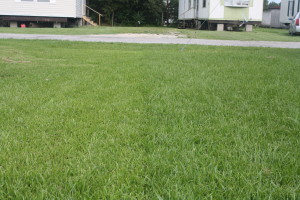
Whether mowed weekly (left side) or somewhat less than that, lawns don’t have the standing cover of dead biomass (meaning previous growth and seed pods) that grasslands do
Obviously one of the defining characteristics of our lawns is that we mow them. Falk (1980) suggested that the average lawn is mowed 30+ times per year. As we trim the growing grass and prevent it from supporting seed pods, we reverse the situation seen in grasslands where total live biomass is exceeded by the standing dead biomass (Golley 1960). Falk (1976) also suggested that regular mowing means there are essentially two types of invertebrates in our lawns: 1) those that live at the tips of grass and can move quickly to get out of danger, and 2) those that live in the upper layer of soil where they are hidden from mowing and protected from being trod upon by the mulch around them.
How do other animals fare? Falk (1976) suggested that lawns offered a bounty of resources for birds that were used to feeding in large groups. According to a study by Blair (1996), however, there is a bit more to benefitting from lawns than just feeding in a flock. While overall bird species diversity was higher in residential areas than in undeveloped areas, non-native birds appeared to benefit at the expense of native birds. He interpreted this to mean that any level of land development was harmful to support of the native bird community. Root & Daniel (1994) felt that mowed lawns in place of grasslands limited the food available for grass-seed eaters, while planting ornamental trees and shrubs in yards increased the food available for birds that eat berries and shrub-seeds. When looking at butterfly communities, the importance of native plant species became very apparent (Blair & Launer 1997). Since butterfly larvae (caterpillars) may depend on specific plants for food, adult butterflies may disappear if those plants aren’t available. This is an interesting situation, since many people (including some related to me) garden with adult butterflies in mind [for example, sowing Monarda spp. (bee balm)]- but, if they don’t provide the food needed by larvae, all those other resources may not help sustain the populations.
So it seems like our lawns fall somewhere in between the natural environment and highly-developed urban environments, although exactly where they fall on that continuum probably has a lot to do with how we manage them on an individual basis. Some of the more recent literature on this topic looks at different management strategies and how we can alter lawn routines to make our spaces more suitable for native wildlife. For my next post, I’ll look at how the science of lawn care is being refined so that we can make more informed choices in creating the lawns we want.
Works cited:
Blair, RB. 1996. Land use and avian species diversity along an urban gradient. Ecological Applications 6: 506-519.
Blair, RB and AE Launer. 1997. Butterfly diversity and human land use: species assemblages along an urban gradient. Biological Conservation 80: 113-125.
Erickson, Je, Cisar, JL, Snyder, GH, Park, DM and KE Williams. 2008. Does a mixed-species landscape reduce inorganic-nitrogen leaching compared to a conventional St. Augustinegrass lawn? Crop Science 48: 1586-1594.
Falk, JH. 1976. Energetics of a suburban lawn ecosystem. Ecology 57: 141-150.
-1980. Taking advantage of local resources: lawns: a case in point. The American Biology Teacher 42: 351-352+355.
Golley, FR. 1960. Energy dynamics of a food chain of an old field community. Ecological Monographs 30: 187-206.
Hawkes, GR ed. 1969. Turfgrass fertilization. California Fertilizer Association, Soil Improvement Committee, Sacramento.
Milesi, C, Running, SW, Elvidge, CD, Dietz, JB, Tuttle, BT and RR Nemani. 2005. Mapping and modeling the biogeochemical cycling of turf grasses in the United States. Environmental Management 36: 426-438.
Nutter, GC and JR Watson. 1969. The turf-grass industry, p. 9-26. In AA Hanson and FV Juska [eds.] Turfgrass Science. Agronomy 14: American Agronomy Society.
Root, T and L McDaniel. 1994. State-by-state winter population trends of select songbirds from 1960 to 1989, p. 21-23. In ET LaRoe, GS Farris, C Puckett, and PD Doran [eds], Our living resources 1994: a report to the nation on the distribution, abundance, and health of United States plants, animals, and ecosystems. National Biological Survey, United States Department of Interior, Washington, D.C., USA.
Thompson, K, Hodgson, JG, Smith, RM, Warren, PH, and KJ Gaston. 2004. Urban domestic gardens (III): composition and diversity of lawn floras. Journal of Vegetation Science 15: 373-378.
Watkins, AJ and JB Wilson. 1992. Fine-scale community structure of lawns. Journal of Ecology 80:15-24.
Last week I came across a reference to the sheer number of acres currently used by our lawns and was pretty impressed at the full extent of the area we water, trim, and curate (around 128,000 square kilometers, which means it uses several times the space used by farmers to grow corn, according to Cristina Milesi and a group at the University of Montana). So we’ve become very, very efficient at managing spaces used more for recreation than for food, and I imagine that has a pretty big impact on the ecosystems our yards adjoin and replace.
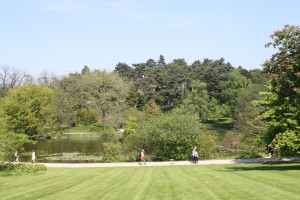
What types of wildlife resources are provided by this beautifully trimmed lawn?
In my work right now, I’m studying the diets of carnivores in different coastal sites of Louisiana- although I’m still working my way through field samples, so far they have used a wide variety of food sources. My impression is they are responding to different levels of food availability throughout the year as seasons change, as well as ways in which we have removed or added resources (still not sure what was so appealing about the Styrofoam and plastic film, but I imagine they smelled like food or were covered with something edible). If our lawns make up such a large part of the environment in some locations, that must have an impact on food availability for wildlife in general- my guess is there are negatives and positives to the presence of maintained yards, for example reducing the number of plant species seeding and fruiting, but also reducing the cover available for prey. And there are probably ways that we can make our yards more wildlife-friendly.
So this month I will be looking into the reality of living in a sea of lawns- are we creating patchworks of single species agriculture? How do our well-cared for yards impact wildlife of all shapes and sizes? And can we get the backyards we want for recreation and aesthetics will still providing important habitat to species that need it?

I’m curious why this marsh rice rat was the only one caught that day, while house mice were abundant
As you might expect after looking through my blog posts from this month, I found a pretty distinct dichotomy in terms of conservation programs that deal with rodents: some projects are trying to get rid of them, and others are trying to protect them. Either way, there are a variety of options for us in terms of helping out, and I also stumbled across a general citizen-scientist opportunity for those of us who like looking at pictures of wildlife.
Looking to help remove invasive species and protect native wildlife?
- You can also adopt a bait station at the Te Kauri Lodge in New Zealand through their ‘Rat? Or Tui?’ program.
More interested in supporting the rodent populations at risk?
- If you live in a coastal area, several states have guidelines for protecting the habitat used by beach mice- Florida is one example.
- In the UK, the Wildlife Trusts has a number of projects which benefit local rodent species, including the water vole.
- The Lincoln Park Zoo has a Meadow Jumping Mouse Recovery project- the zoo has a variety of opportunities to support their work through volunteering, becoming a member, donating, and joining them in a marathon.
- And if you are interested in starting a community-wide conservation initiative to help rodents (and other species), Wildlife Support and Conservation provides a really good example of that type of effort, including their interest in dormice and yellow-necked mice.
For those of us who simply enjoy looking at pictures of wildlife, whether or not they contain rodents, the Zoological Society of London’s Edge of Existence wants our help in identifying the species in wildlife camera pictures from around the world– it’s a great chance to see wildlife from a variety of countries and help scientists organize their data.
When I started looking into rodent conservation, what I had expected to find was a tail of two species groups: 1) invasive, introduced rodent species dominating the natives, and 2) disappearing native species and simplified ecosystems as a result of habitat loss to human activities. It would appear, however, that the global situation is a bit more complex than that.
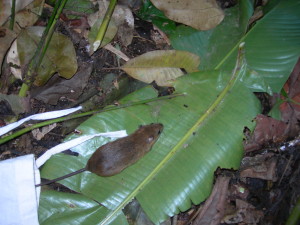
This rat lives in Bolivia’s rainforest- one question researchers have is how logging practices impact rodents in a habitat where travel between places is often by hanging vines
While there are plenty of stories about big bad black rats taking over whole ecosystems (and their effects also appear to linger- according to Jones (2010), New Zealand islands that had experienced rat eradication but no managed seabird recolonization had still not reverted back to pre-invasion nutrient cycling 7-10 year later), the rats may also have a positive contribution to make. We might prefer native species of rodent, but sometimes our development activities have already left those species high and dry. This can have effects that ripple throughout the ecosystem as important relationships break down. In the case of at least one fragmented ecosystem in Australia, however, the black rats that are quite happy to live in our developed landscapes may be able to step in and fulfill some of those lost ecosystem roles- Vernes and McGrath (2009) found that black rats fed on 24 taxa of fungus, making them potentially important spore dispersers in areas where the native dispersers have been extirpated. And black rats may not be as all-powerful as they seem. While investigating the degree and type of competition between black rats and bush rats in an Australian rainforest, Stokes et al. (2009) suggested that human-caused change in the ecosystem was what had given the black rats the initial invasion opportunity- once a rat removal program lowered black rat abundance, the bush rats were able to both increase their population and successfully defend their territories against black rats. This suggests that there are ways to make an ecosystem and a population more invasion resistant, which could be very important for preventing future species declines.
And rodent species are not just facing local habitat loss issues. Larger weather pattern changes are becoming a bigger problem, too. Decreased rainfall within Africa’s sahel means that more desert-like habitat, and the rodents that are adapted to those conditions, are pushing south (Thiam et al. 2011). These drier conditions have made things more difficult for the local rodent species, some of which are now in decline. This is not quite the usual invasive species scenario, since the desert rodents are moving with their habitat, nor is it the typical habitat loss story since the scale of the change is continental rather than local. An ocean away, researchers in Chile are concerned about the impact of stronger and more frequent El Nino events for arid environment rodents (Meserve et al. 2011)- since local species respond differently to periods of intense rainfall (depending on how long-lived they are- the longer-lived species wait until year 2 or 3 of high rainfall before populations start to jump, while shorter-lived species only respond in year 1), a change in frequency of high-rainfall years could really alter the rodent community. If we know more about the population dynamics of a species, we can better predict how they will respond to and whether they will survive an environmental crisis (Harris and Macdonald 2007).
In reading about more recent investigation into rodent populations around the world, I was struck by how individual each situation was– black rats invade and are bad, black rats invade and we can limit their impact, black rats invade and can be helpful, etc. So there is a lot of variation in the situation facing rodent populations and I think in the prognosis for their survival as well [Stokes et al. (2009) felt Australian bush rats could regain some of their ground with help in black rat removal, while Firth et al. (2010) predicted the brush-tailed rabbit-rat would be extirpated from Australia’s Northern Territory mainland within ten years due to habitat changes if conservation action wasn’t taken].
With so much still to learn about the issues facing, or caused by, rodent species, my guess is that there are also opportunities for us to get involved in the research and conservation efforts. In my final post of the month, I’ll look for ways to directly participate in the work being done.
Works cited:
Firth, RSC, Brook, BW, Woinarski, JCZ, and DA Fordham. 2010. Decline and likely extinction of a northern Australian native rodent, the brush-tailed rabbit-rat Conilurus penicillatus. Biological Conservation 143: 1193-1201.
Harris, DB and DW Macdonald. 2007. Population ecology of the endemic rodent Nesoryzomys swarthi in the tropical desert of the Galapagos Islands. Journal of Mammalogy 88: 208-219.
Jones, HP. 2010. Prognosis for ecosystem recovery following rodent eradication and seabird restoration in an island archipelago. Ecological Applications 20: 1204-1216.
Meserve, PL, Kelt, DA, Previtali, MA, Milstead, WB, and JR Gutierrez. 2011. Global climate change and small mammal populations in north-central Chile. Journal of Mammalogy 92: 1223-1235.
Stokes, VL, Banks, PB, Pech, RP, and DM Spratt. 2009. Competition in an invaded rodent community reveals black rats as a threat to native bush rats in littoral rainforest of south-eastern Australia. Journal of Applied Ecology 46: 1239-1247.
Thiam, M, Atteynine, SA, Traore, S, Duplantier, J-M, Maurel, D, and B Sicard. 2011. Capacity for water conservation in invasive (Gerbillus nigeriae) and declining rodents (Taterillus pygargus and Taterillus gracilis) that exhibit climate-induced distribution changes in Senegal. Journal of Arid Environments 75: 998-1007.
Vernes, K and K McGrath. 2009. Are introduced black rats (Rattus rattus) a functional replacement for mycophagous native rodents in fragmented forests? Fungal Ecology 2: 145-148.
As I mentioned in my first post of the month, I’m interested in learning about the conservation status of rodent species. I think I may have overlooked the threats facing them because several species (notably the black and Norwegian rats) have been incredibly successful invasive species. When I started looking through the literature, I found that there is something of a split when it comes to conservation status: some species are surviving precariously and others are living large.
It’s no surprise that I found a good number of studies detailing the negative impacts of invasive rodent species– given the success with which house mice and black and Norwegian rats have been our traveling companions, we should expect them to have wide-ranging impacts. In addition to causing problems for nesting seabirds as I mentioned in an earlier post, these species are also a threat to passerine birds in Hawaii (VanderWerf 2001) and even their own closer relations- introduced rats in Madagascar, for example, use many of the same resources as the 14 native species of rodent (Goodman 1995) and the competition between the species is likely to continue increasing as more and more habitat is lost. This could be a problem for the native species of Madagascar, since a study by Bolger et al. (1997) in California found that native rodent species were more likely to disappear from habitat fragments than introduced species.
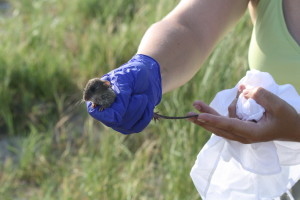
Marsh rice rats are common along the Gulf Coast, but I haven’t trapped them at all of my sites- not exactly sure why.
Native rodent species are threatened by other issues as well. It might surprise you to learn (I was certainly astounded) that 51% of the terrestrial mammal species that have gone extinct within the last 500 years were rodents (Ceballos & Brown 1995)- why are we not hearing more about this? According to Amori and Gippoliti (2001) Brazil’s Atlantic Forest is a hotspot of threatened rodent species in the Neotropics. One species of spiny rat (Trinomys eliasi) has been reduced to only two populations in the wild, one of which is in a human-impacted area (Brito & de Souza Lima Figueiredo 2003). By 1996 nine species of Australian conilurine rodents had already gone extinct (Smith & Quin 1996).
What is causing rodent population declines? Several of the usual suspects make an appearance in this one- habitat loss and degradation are clearly issues. Whether it’s habitat becoming fragmented, as in California, or changes in vegetation height caused by large herbivore (for example sheep or cows) grazing (Smit et al. 2001), some rodent species are losing access to the resources they need. Invasive species are also a problem, sometimes as competition, sometimes as predators, and sometimes because of what they help predators do- in Australia, the presence of predatory red foxes and domestic cats is amplified by the invasive prey species (Smith & Quin 1996). Normally a predator would not hunt a prey species to extinction because, as the prey becomes less abundant, the number of predators is also reduced- in the case of Australian rodents, however, the abundance of invasive prey species (especially rabbits), gives predators enough other food options to keep their populations, and pressure on native species, up. For other species, like the prairie deer mouse, we’re not sure what is causing the decline (Pergams & Nyberg 2005).
Why should we be worried about rodent species– don’t we have too many rats as it is? Small rodents tend to eat a lot of vegetative matter, including seeds. While this could be a problem for rare plant species, when rodents focus on more prolific plant species they can help maintain a diverse plant community (Brown & Heske 1990). And since many seed-eating rodents tend to store food for leaner times, not all of which seeds are recovered for food, those forgotten caches can be really important in helping seeds disperse into a wider area. In the case of antelope bitterbrush seeds at a western Nevada site, for example, more than 99% of new seedlings were the result of chipmunk caches (Vander Wall 1994)- that’s pretty fantastic! At least one study has suggested that we could even take advantage of this trait to promote seed dispersal (Longland & Bateman 1998) by providing ‘decoy seeds’ that could be stored and then neglected as rodents consume their favorite seeds first.
So although some rodent species have been entirely too successful in our eyes, other species are facing uncertain futures. For my next post, I’ll take a look at more recent developments in rodent conservation and try to get a sense of efforts being made to support populations in trouble.
Works cited:
Amori, G and S Gippoliti. 2001. Identifying priority ecoregions for rodent conservation at the genus level. Oryx 35: 158-165.
Bolger, DT, Alberts, AC, Sauvajot, RM, Potenza, P, McCalvin, C, Tran, D, Mazzoni, S and ME Soule. 1997. Response of rodents to habitat fragmentation in coastal southern California. Ecological Applications 7: 552-563.
Brito, D and M de Souza Lima Figueiredo. 2003. Minimum viable population and conservation status of the Atlantic Forest spiny rat Trinomys eliasi. Biological Conservation 112: 153-158.
Brown, JH and EJ Heske. 1990. Control of a desert-grassland transition by a keystone rodent guild. Science 250: 1705-1707.
Ceballos, G and JH Brown. 1995. Global patterns of mammalian diversity, endemism, and endangerment. Conservation Biology 9: 559-568.
Goodman, SM. 1995. Rattus on Madagascar and the dilemma of protecting the endemic rodent fauna. Conservation Biology 9: 450-453.
Longland, WS and SL Bateman. 1998. Implications of desert rodent seed preferences for range remediation. Journal of Range Management 51: 679-684.
Pergams, ORW and DW Nyberg. 2005. Evaluating the predicted local extinction of a once-common mouse. Conservation Biology 19: 1312-1317.
Smit, R, Bokdam, J, den Ouden, J, Olff, H, Schot-Opschoor, H, and M Schrijvers. Effects of introduction and exclusion of large herbivores on small rodent communities. Plant Ecology 155: 119-127.
Smith, AP and DG Quin. Patterns and causes of extinction and decline in Australian conilurine rodents. Biological Conservation 77: 243-267.
Vander Wall, SB. 1994. Seed fate pathwats of antelope bitterbrush: dispersal by seed-caching yellow pine chipmunks. Ecology 75: 1911-1926.
VanderWerf, EA. 2001. Rodent control decreases predation on artificial nests on O’ahu ‘Elepaio habitat. Journal of Field Ornithology 72: 448-457.
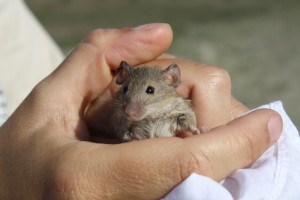
I caught this house mouse in beach vegetation
I’ve spent a good chunk of time over the past 2 months putting out small mammal traps to catch rodents at different field sites in coastal Louisiana. My goal is to understand the prey base of local carnivores and then figure out if they are being selective about what they eat or simply taking prey as they find it. Most of the time I catch marsh rice rats and house mice (although ghost crabs seem irresistibly drawn toward the metal boxes- they always throw the cotton balls out before taking up residence); the rats are a native species we expect to see in Louisiana coastal habitats, the mice were originally stowaways with humans on the move.
During my most recent trapping session, I was talking with one of the site employees about my work. When she found out I was trapping rodents, she said, “Oh, good- I hope you get rid of a bunch of them.” I was a bit surprised by that reaction. Seeing the look on my face, she then said, “Do you release them?” Since I want to understand how these rats and mice are part of the entire coastal ecosystem and interact with carnivore species, I don’t want to remove them through trapping because that would distort relationships and population abundance. I want to know what species are there, have a relative sense of abundance, and then figure out what that means for carnivores. I use live Sherman traps to trap rodents; I take body and weight measurements, determine species and sex, and then let them go (sometimes they expedite the process through active resistance- a friend got a pretty nice picture of a mouse in mid-escape).
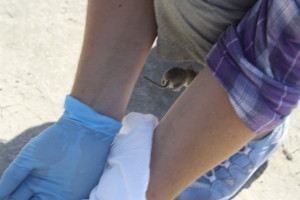
She was just waiting for her chance to make a break for it
Her reaction got me thinking about the human-rodent relationship and our shared history and how we tend to view them with fear and/or disgust. It wasn’t until I helped with small mammal research in Bolivia that I realized that rats could be cute (an Oecomys trinitatus even featured on my Christmas card that year). The rats I catch here in Louisiana range from scraggly looking to adorable, but that’s not the way that many people see them because they are rats, and we know that rats can be invasive species destroying the eggs of native birds or they can be carriers of disease or, if you’re familiar with Mrs. Frisby and the Rats of NIMH, they can be almost creepily intelligent.
And now I’m wondering about the status of native rodent species around the world- are they all adaptable to human presence and the environmental changes we’ve created, or are some species in trouble? And are we actually paying attention to them as a conservation issue or just looking at them as pests in every ecosystem?
So this month I’ll be digging into the rodent world, trying to understand the conservation issues connected with rats and mice. It may be that everything I find relates to black and Norwegian rats invading seabird colonies and spreading diseases, but it may also be that some species are dependent on specific habitats we have altered or eliminated. So, even if it gives you the creeps a bit to think about these animals, hopefully I can provide a more complete view of their ecology and situation around the world.
In my reading about hermit crabs over the last few weeks, I’ve certainly gotten the sense that most hermit crab species aren’t in particularly precarious positions with regard to survival. While king crabs and coconut crabs are an exception, most species seem to be doing pretty well at the moment. That trend is likely to change, however, as the effects of global warming and ocean acidification become more obvious and intense. And a variety of other crab species are already feeling pressure from human activities.
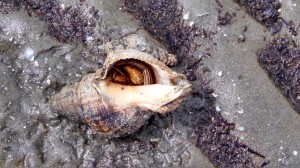
I found this hermit crab on an island in Barataria Bay, Louisiana as the tide was dropping.
The good news is that there are things we can do to support crab populations around the world- the suggestions that follow start with hermit crab conservation and then expand to a few other species since you may have a favorite that I haven’t mentioned before.
How to keep hermits in good shape:
- According to the Monterey Bay Aquarium, removing live crabs from tidal pools is a no-go, but we should also be wary of removing empty shells since hermits depend on a regular supply as they move up the property ladder
- Since hermit crabs are an important component of mangrove swamps and marshes, you can help crab populations around the world by contributing to the Mangrove Action Project– you can adopt a specific project which will benefit ecosystems and human populations
- Island Conservation works, in part, to help coconut crabs and they can always use volunteers and/or donations
- If you are interested in learning more about and supporting efforts to help king crab populations in Alaska, check out the Alaska Marine Conservation Council for ways to get involved
For other species of crab:
- Florida Fish & Wildlife is looking for help to document the location of horseshoe crab nests, and they also have programs for blue crabs and stone crabs
And for crabs in your cooking:
As I mentioned in my last post, ocean acidification is likely to cause problems for hermit crabs both because the calcium carbonate used by snails to construct shells which are, in turn, used by hermits will be less available and because hermits exhibit less movement and environmental awareness as pH drops. A variety of aquatic animals are likely to have similar problems as climate change progresses.

I found this hermit crab on an island in Barataria Bay, Louisiana as the tide was dropping.
In my reading this week, I learned that other developments, some connected to climate change, will also create problems for hermit crabs. As water gets warmer, it is less able to hold dissolved oxygen, which means that there is less available for aquatic organisms to use. Global warming is predicted to reduce dissolved oxygen levels around the world, and then this may be combined with increased nutrient levels from agricultural and other run-off, so that reduced oxygen events become even more intense. When Riedel et al. (2012) tested the responses of several groups of benthic fauna (such as worms, molluscs, and sea urchins) to reduced or non-existent oxygen levels, they found that hermit crabs, although being among the most tolerant of decapods, were still quite sensitive to reduced oxygen levels. The crabs attempted to find refuges with more oxygen and often died before dissolved oxygen was completely gone. Since we can expect warmer seas and more aquatic events with severely reduced oxygen, we can also expect more sensitive species, such as sea urchins and hermit crabs, to fare badly during these events. Why does this matter? Well, we may find that biodiversity is severely reduced in some areas as the more sensitive species disappear, and that can make the entire system less likely to recover from disturbances.
Although I was initially surprised to learn it, some hermit crab populations are also at risk from invasive terrestrial species. The yellow crazy ant (Anoplolepis gracilipes) is an invasive species throughout the tropics and subtropics which consumes carrion as part of its diet and can spray formic acid in defense and aggression. On islands in Tokelau where yellow crazy ants had established colonies, hermit crab densities were lower and the ants were able to exclude the crabs from specific food resources by spraying their heads with formic acid (McNatty et al. 2009). The crabs were less of a presence in island interiors and fed lower down the food chain when the ants were present. How could this change island ecology? Hermit crabs are important aerators of marsh soil and have an impact on plant distribution and abundance, so we could find that plant communities are changing when hermit crabs are less common. And although it wasn’t documented in McNatty et al.’s study, O’Dowd et al. (2003) found that these ants had extirpated red land crab populations on Christmas Island.
Our own marine activities have also created some problems for hermit crab species. Although they may not look like it, king crabs are hermits, and Bristol Bay, Alaska witnessed a red king crab population collapse in the early 1980s due to pot fishing and trawling for ground fish (Dew & McConnaughey 2005). The stock had still not recovered 20 years later because crabs moving from nursery areas to breeding areas had to traverse ‘cod alley’ where they were often scooped up by trawlers and the crab harvest itself targeted just males, leaving a very skewed sex ratio.
Although hermit crabs may seem pretty durable and present in so many habitats, some species, such as coconut and king crabs, have already experienced population declines (Wang et al. 2007), and the outlook for the future suggests that more are likely to do so as our oceans acidify and contain less dissolved oxygen. And the challenges of climate change and invasive species are likely to affect a wide variety of crustaceans, so it makes sense to start thinking about ways to support these populations. In my final post of the month, I’ll take a look at crab conservation efforts and hopefully dig up a few ways for us to get involved in all of that.
Works cited:
Dew, CB and RA McConnaughey. 2005. Did trawling on the brood stock contribute to the collapse of Alaska’s king crab? Ecological Applications 15: 919-941.
McNatty, A, Abbott, KL, and PJ Lester. 2012. Invasive ants compete with and modify the trophic ecology of hermit crabs on tropical islands. Oecologia 160: 187-194.
O’Dowd, DJ, Green, PT, and PS Lake. 2003. Invasional ‘meltdown’ on an oceanic island. Ecology Letters 6: 812-817.
Riedel, B, Zuschin, M, and M Stachowitsch. 2012. Tolerance of benthic macrofauna to hypoxia and anoxia in shallow coastal seas: a realistic scenario. Marine Ecology Progress Series 458: 39-52.
Wang, F-L, Hsieh, H-L, and C-P Chen. 2007. Larval growth of the coconut crab Birgus latro with a discussion on the development mode of terrestrial hermit crabs. Journal of Crustacean Biology 27: 616-625.

 As it turns out, there are lots of resources for information and many, many ways we can make small changes to how we care for the spaces around our homes. One of the suggestions from a study in New Jersey (Mitteager et al. 2006) when approaching our yards is to think about the yard image we want to see when we look outside rather than specific plants we want to use- that way we have more opportunities to incorporate native plant species while still getting the yard-feel we want.
As it turns out, there are lots of resources for information and many, many ways we can make small changes to how we care for the spaces around our homes. One of the suggestions from a study in New Jersey (Mitteager et al. 2006) when approaching our yards is to think about the yard image we want to see when we look outside rather than specific plants we want to use- that way we have more opportunities to incorporate native plant species while still getting the yard-feel we want.








